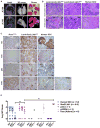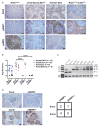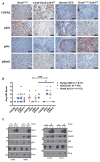Sox2 cooperates with Lkb1 loss in a mouse model of squamous cell lung cancer
- PMID: 24953650
- PMCID: PMC4410849
- DOI: 10.1016/j.celrep.2014.05.036
Sox2 cooperates with Lkb1 loss in a mouse model of squamous cell lung cancer
Abstract
Squamous cell carcinoma (SCC) of the lung is the second most common subtype of lung cancer. With limited treatment options, the 5-year survival rate of SCC is only 15%. Although genomic alterations in SCC have been characterized, identifying the alterations that drive SCC is critical for improving treatment strategies. Mouse models of SCC are currently limited. Using lentiviral delivery of Sox2 specifically to the mouse lung, we tested the ability of Sox2 to promote tumorigenesis in multiple tumor suppressor backgrounds. Expression of Sox2, frequently amplified in human SCC, specifically cooperates with loss of Lkb1 to promote squamous lung tumors. Mouse tumors exhibit characteristic histopathology and biomarker expression similar to human SCC. They also mimic human SCCs by activation of therapeutically relevant pathways including STAT and mTOR. This model may be utilized to test the contribution of additional driver alterations in SCC, as well as for preclinical drug discovery.
Copyright © 2014 The Authors. Published by Elsevier Inc. All rights reserved.
Figures



Similar articles
-
Dysregulated Tgfbr2/ERK-Smad4/SOX2 Signaling Promotes Lung Squamous Cell Carcinoma Formation.Cancer Res. 2019 Sep 1;79(17):4466-4479. doi: 10.1158/0008-5472.CAN-19-0161. Epub 2019 Jun 17. Cancer Res. 2019. PMID: 31209059
-
SOX2 in squamous cell carcinoma: amplifying a pleiotropic oncogene along carcinogenesis.Cell Cycle. 2010 Apr 15;9(8):1480-6. doi: 10.4161/cc.9.8.11203. Epub 2010 Apr 15. Cell Cycle. 2010. PMID: 20372069
-
Sex-Determining Region Y-box 2 Promotes Growth of Lung Squamous Cell Carcinoma and Directly Targets Cyclin D1.DNA Cell Biol. 2017 Apr;36(4):264-272. doi: 10.1089/dna.2016.3562. Epub 2017 Feb 2. DNA Cell Biol. 2017. PMID: 28151013
-
Association of SOX2 and Nestin DNA amplification and protein expression with clinical features and overall survival in non-small cell lung cancer: A systematic review and meta-analysis.Oncotarget. 2016 Jun 7;7(23):34520-31. doi: 10.18632/oncotarget.9145. Oncotarget. 2016. PMID: 27150062 Free PMC article. Review.
-
[Advances on driver oncogenes of squamous cell lung cancer].Zhongguo Fei Ai Za Zhi. 2014 May;17(5):433-6. doi: 10.3779/j.issn.1009-3419.2014.05.13. Zhongguo Fei Ai Za Zhi. 2014. PMID: 24854563 Free PMC article. Review. Chinese.
Cited by
-
Reprogramming of the esophageal squamous carcinoma epigenome by SOX2 promotes ADAR1 dependence.Nat Genet. 2021 Jun;53(6):881-894. doi: 10.1038/s41588-021-00859-2. Epub 2021 May 10. Nat Genet. 2021. PMID: 33972779 Free PMC article.
-
Somatic Pluripotent Genes in Tissue Repair, Developmental Disease, and Cancer.SPG Biomed. 2018;1(2):10.32392/biomed.18. doi: 10.32392/biomed.18. Epub 2018 Oct 28. SPG Biomed. 2018. PMID: 31172135 Free PMC article.
-
Chromosome 3q26 Gain Is an Early Event Driving Coordinated Overexpression of the PRKCI, SOX2, and ECT2 Oncogenes in Lung Squamous Cell Carcinoma.Cell Rep. 2020 Jan 21;30(3):771-782.e6. doi: 10.1016/j.celrep.2019.12.071. Cell Rep. 2020. PMID: 31968252 Free PMC article.
-
Proteomic analysis of lung cancer cells reveals a critical role of BCAT1 in cancer cell metastasis.Theranostics. 2021 Sep 27;11(19):9705-9720. doi: 10.7150/thno.61731. eCollection 2021. Theranostics. 2021. PMID: 34646394 Free PMC article.
-
LKB1 phosphorylation and deactivation in lung cancer by NNAL, a metabolite of tobacco-specific carcinogen, in an isomer-dependent manner.Oncogene. 2022 Aug;41(33):4042-4054. doi: 10.1038/s41388-022-02410-x. Epub 2022 Jul 14. Oncogene. 2022. PMID: 35835853
References
-
- Brcic L, Sherer CK, Shuai Y, Hornick JL, Chirieac LR, Dacic S. Morphologic and clinicopathologic features of lung squamous cell carcinomas expressing Sox2. Am J Clin Pathol. 2012;138:712–718. - PubMed
Publication types
MeSH terms
Substances
Grants and funding
LinkOut - more resources
Full Text Sources
Other Literature Sources
Medical
Molecular Biology Databases
Research Materials
Miscellaneous

